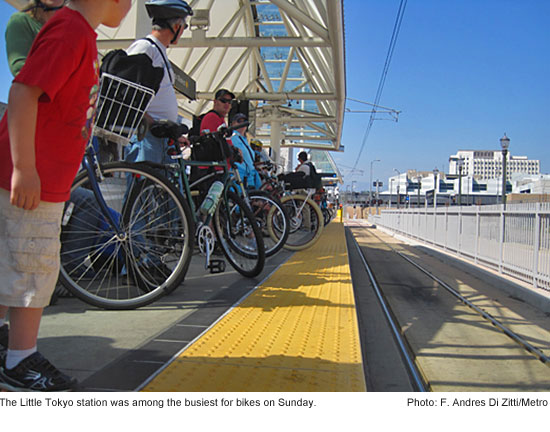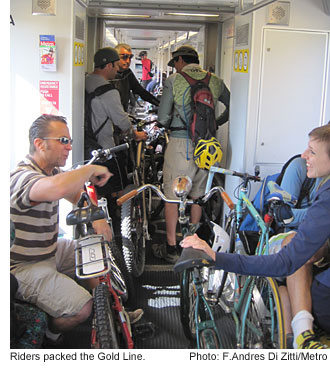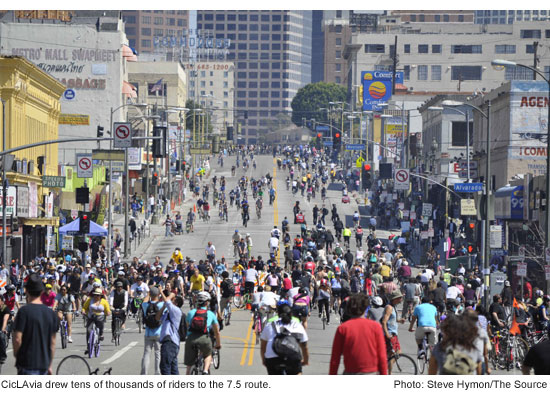Bikes make tracks on Metro trains
April 13, 2011
 When Metro volunteers checked out the bike-toting crowds on downtown transit platforms Sunday morning, a thought straight out of “Jaws” leapt out at them:
When Metro volunteers checked out the bike-toting crowds on downtown transit platforms Sunday morning, a thought straight out of “Jaws” leapt out at them:
We’re gonna need a bigger train.
Sunday’s CicLAvia ride through Los Angeles streets was not just a test of the city’s ability to embrace a car-free existence for a few hours. It also was a test of Metro’s ability to cope with the largest congregation of bicycle commuters it’s ever faced, as thousands turned to public transportation to get them to and from the 7.5 mile route.
And—while it’s certain that many riders encountered delays, crowded train cars or both—it’s clear that the event was a milestone in the agency’s evolving track record of accommodating bicycles aboard its subway and light rail trains.
“I think it was a great opportunity to show that bikes and commuters and trains can all coexist,” said Andres Di Zitti, a Metro transportation planner who took part in the event as a volunteer and photographed some of the action. “This year, there were many more people and we were able to respond quickly…As we got to downtown, and saw the big turnout and the platforms starting to fill up, we called the operations managers and they sent longer trains out. It was definitely a good learning experience for us.”
Bruce Shelburne, a director in Metro operations, was on the receiving end of many of those phone calls. His staff was able to respond by quickly adding extra cars to trains on the Red, Purple and Gold lines—doubling capacity in some cases. They also had a couple of standby trains available, and those were pressed into service as well.
“We handled a pretty stressful day,” Shelburne said. “There’s no transit agency in the world that could have processed the amount of bikes that we had out there, period. I haven’t heard any complaints yet. I’m sure we’ll get some. But overall, it was a positive experience.”
Joe Linton, a longtime bike activist and one of CicLAvia’s organizers, said Metro did a good job of making more room for cyclists on its trains during the event. “I heard that some trains were very crowded—which is a good problem to have,” Linton said.
Sunday’s CicLAvia was the city’s second, and two more are in the works, tentatively scheduled for July 10 and October 9. Both will follow the same basic route, although a “spur” to the USC/Exposition Park area may be added, along with a Chinatown segment.
At the same time, Metro is considering plans to open up its trains for more bike commuters every day—not just CicLAvia Sundays.
Bikes currently are banned from Metro trains during peak commuting hours. That could change under a proposal set to go before Metro’s Operations Committee on April 21. The committee also will consider whether to spend $950,000 to remove some seats from light rail cars to make more room for bicycles. Seats already have been removed from Metro subway cars, Shelburne said.
Carving out more room for bikes and other items onboard the trains is a testament to changing commuting habits. “Back in 1990, the biggest thing we ever saw on a train was a briefcase,” Shelburne said. “Now everybody takes their life’s belongings with them.”
Accommodating cyclists by allowing them to ride the trains anytime could carry more than just symbolic value, according to a staff report urging reversal of the peak-hour ban.
“Elimination of time restrictions would allow unfettered access to the rail system,” the report said. “This would encourage more people to ride transit knowing that they would be allowed to begin and end their trips using bicycles; reduce their carbon footprints as more cars come off the road and increase MTA ridership leading to a more sustainable environment.”
Although CicLAvia was a special event, it offered insights into how bikes and trains can coexist better day in and day out, Shelburne said.
“Every time we do this event, we find some things that were done wrong,” Shelburne said. A biggie: “Passengers need to understand they cannot block doors on the trains. We have to probably provide a little more education.”













 405 bridge work causes a stink
405 bridge work causes a stink

